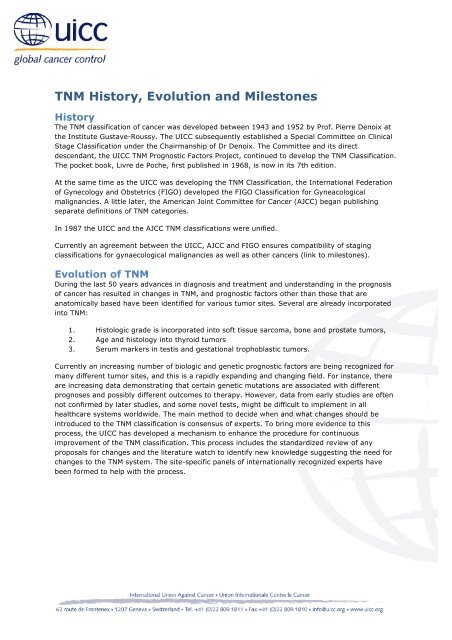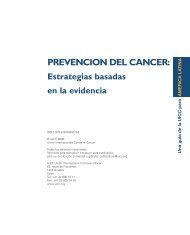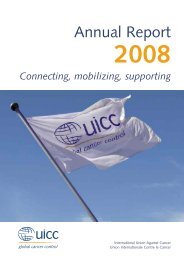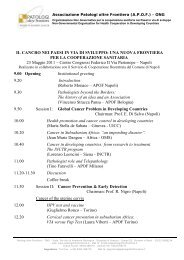TNM History, Evolution and Milestones
TNM History, Evolution and Milestones
TNM History, Evolution and Milestones
Create successful ePaper yourself
Turn your PDF publications into a flip-book with our unique Google optimized e-Paper software.
<strong>TNM</strong> <strong>History</strong>, <strong>Evolution</strong> <strong>and</strong> <strong>Milestones</strong><br />
<strong>History</strong><br />
The <strong>TNM</strong> classification of cancer was developed between 1943 <strong>and</strong> 1952 by Prof. Pierre Denoix at<br />
the Institute Gustave-Roussy. The UICC subsequently established a Special Committee on Clinical<br />
Stage Classification under the Chairmanship of Dr Denoix. The Committee <strong>and</strong> its direct<br />
descendant, the UICC <strong>TNM</strong> Prognostic Factors Project, continued to develop the <strong>TNM</strong> Classification.<br />
The pocket book, Livre de Poche, first published in 1968, is now in its 7th edition.<br />
At the same time as the UICC was developing the <strong>TNM</strong> Classification, the International Federation<br />
of Gynecology <strong>and</strong> Obstetrics (FIGO) developed the FIGO Classification for Gyneacological<br />
malignancies. A little later, the American Joint Committee for Cancer (AJCC) began publishing<br />
separate definitions of <strong>TNM</strong> categories.<br />
In 1987 the UICC <strong>and</strong> the AJCC <strong>TNM</strong> classifications were unified.<br />
Currently an agreement between the UICC, AJCC <strong>and</strong> FIGO ensures compatibility of staging<br />
classifications for gynaecological malignancies as well as other cancers (link to milestones).<br />
<strong>Evolution</strong> of <strong>TNM</strong><br />
During the last 50 years advances in diagnosis <strong>and</strong> treatment <strong>and</strong> underst<strong>and</strong>ing in the prognosis<br />
of cancer has resulted in changes in <strong>TNM</strong>, <strong>and</strong> prognostic factors other than those that are<br />
anatomically based have been identified for various tumor sites. Several are already incorporated<br />
into <strong>TNM</strong>:<br />
1. Histologic grade is incorporated into soft tissue sarcoma, bone <strong>and</strong> prostate tumors,<br />
2. Age <strong>and</strong> histology into thyroid tumors<br />
3. Serum markers in testis <strong>and</strong> gestational trophoblastic tumors.<br />
Currently an increasing number of biologic <strong>and</strong> genetic prognostic factors are being recognized for<br />
many different tumor sites, <strong>and</strong> this is a rapidly exp<strong>and</strong>ing <strong>and</strong> changing field. For instance, there<br />
are increasing data demonstrating that certain genetic mutations are associated with different<br />
prognoses <strong>and</strong> possibly different outcomes to therapy. However, data from early studies are often<br />
not confirmed by later studies, <strong>and</strong> some novel tests, might be difficult to implement in all<br />
healthcare systems worldwide. The main method to decide when <strong>and</strong> what changes should be<br />
introduced to the <strong>TNM</strong> classification is consensus of experts. To bring more evidence to this<br />
process, the UICC has developed a mechanism to enhance the procedure for continuous<br />
improvement of the <strong>TNM</strong> classification. This process includes the st<strong>and</strong>ardized review of any<br />
proposals for changes <strong>and</strong> the literature watch to identify new knowledge suggesting the need for<br />
changes to the <strong>TNM</strong> system. The site-specific panels of internationally recognized experts have<br />
been formed to help with the process.
<strong>Milestones</strong> in <strong>TNM</strong> history<br />
1940s Dr Pierre Denoix developed the <strong>TNM</strong> Classification of Cancer Stage at the Institut<br />
Gustave-Roussy, France. Subsequently, UICC established a Committee on Clinical<br />
Stage Classification under his leadership <strong>and</strong> continued to develop the <strong>TNM</strong><br />
Classification.<br />
1953 Publication of the "Uniform Technique for a Clinical Classification by the <strong>TNM</strong><br />
System" 1 .<br />
1968 UICC <strong>TNM</strong> pocket book, "the Livre de Poche", 1st edition<br />
1974 UICC Livre de Poche, 2nd edition<br />
1982 UICC <strong>TNM</strong> Classification, 3rd edition<br />
In subsequent years<br />
The International Federation of Gynaecology <strong>and</strong> Obstetrics (FIGO) developed the<br />
FIGO Classification for Gynaecological Malignancies<br />
The American Joint Committee for Cancer (AJCC) began publishing separate<br />
definitions of <strong>TNM</strong> categories<br />
1982 UICC <strong>TNM</strong> Atlas, 1st edition, a graphic guide to the <strong>TNM</strong> Classification<br />
1985 UICC <strong>TNM</strong> Atlas, 2nd edition<br />
1987 Unification of the UICC <strong>and</strong> AJCC <strong>TNM</strong> classifications<br />
UICC <strong>TNM</strong> Classification of Malignant Tumours, 4th edition<br />
1989 UICC <strong>TNM</strong> Atlas, 3rd edition<br />
1993 UICC <strong>TNM</strong> Supplement, 1st edition, a commentary on uniform use<br />
1995 UICC Prognostic Factors, 1st edition<br />
1997 UICC <strong>TNM</strong> Classification of Malignant Tumours, 5th edition<br />
UICC <strong>TNM</strong> Atlas, 4rd edition<br />
1998 UICC <strong>TNM</strong> Interactive CD Rom<br />
2001 UICC <strong>TNM</strong> Supplement, 2nd edition<br />
UICC Prognostic Factors, 2nd edition<br />
2002 UICC <strong>TNM</strong> Mobile Edition 2.0<br />
UICC <strong>TNM</strong> Classification of Malignant Tumours, 6th edition<br />
2003 UICC <strong>TNM</strong> Online / Wiley<br />
UICC <strong>TNM</strong> Supplement, 3rd edition<br />
2004 UICC <strong>TNM</strong> Atlas, 5th edition<br />
2006 Prognostic Factors in Cancer, 3rd edition<br />
1 1. It was accepted as the basis for the classification proposals for breast <strong>and</strong> laryngeal cancer by<br />
the International Commission on Stage Grouping of Cancer <strong>and</strong> the Presentation of Results (ICPR).









